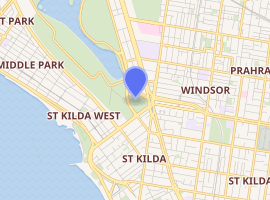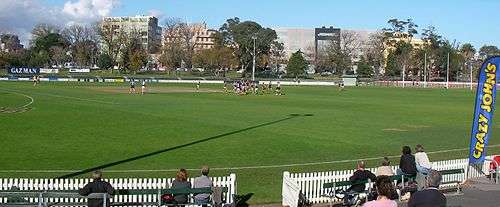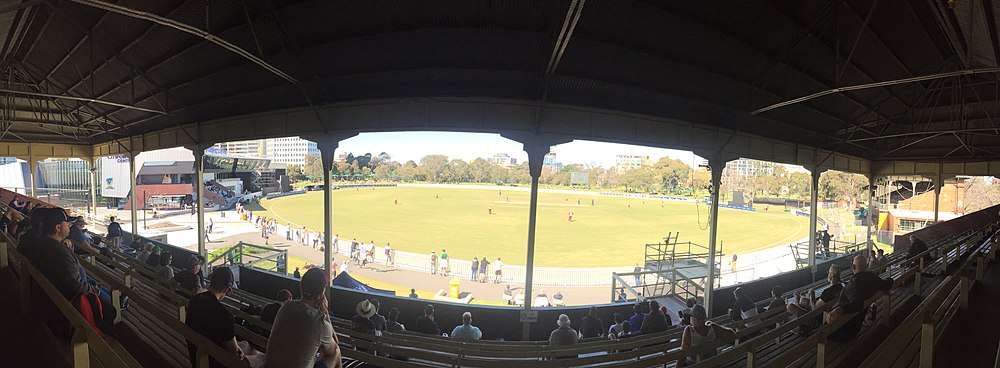Junction Oval
Junction Oval (also known as the St Kilda Cricket Ground or by its sponsored name CitiPower Centre) is a historic sports ground in the suburb of St Kilda in Melbourne, Victoria, Australia. Its location near the St Kilda Junction gave rise to its name. It is located approximately five kilometres from the centre of Melbourne and is in the southernmost part of the large Albert Park sporting precinct.
Victoria v South Australia cricket teams match at the Junction Oval, September 2018 | |

| |
| Location | St Kilda, Victoria |
|---|---|
| Coordinates | 37°51′21″S 144°58′48″E |
| Owner | Government of Victoria |
| Operator | Cricket Victoria |
| Capacity | 7,000[1] |
| Surface | Grass (Oval) |
| Construction | |
| Opened | 1856 |
| Renovated | 2015–18 |
| Construction cost | $40 million (2015–18 redevelopment) |
| Tenants | |
Victoria cricket team (2018–present)
St Kilda cum University Football Club (Challenge Cup; 1875) South Melbourne Football Club (VFL; 1944–1946) Fitzroy Football Club (VFL; 1970–1984) | |
| Ground information | |
| Tenants | Victoria cricket team |
| As of 28 May 2020 Source: Cricinfo | |
Between 2015 and 2018, the oval underwent a $40 million redevelopment designed to make it the administrative headquarters of Cricket Victoria.
History
Junction Oval was established on its present site in 1856. The first grandstand at the ground was purchased from the old Elsternwick racecourse and erected in 1892 at the southern end of the ground. A new grandstand was built in 1925–6 at a cost of £7000, designed by the architect E J Clark and built by H H Eilenberg. It was originally called the G P Newman Stand but has been renamed the Kevin Murray Stand after one of the Fitzroy Football Club's most famous footballers. A second brick stand designed by E J Clark to complement the Murray Stand was built by H H Eilenberg in 1933–4 at a cost of £7500. It was named the Don Blackie-Bert Ironmonger Stand in honour of the St Kilda Cricket Club and Test cricketers. It still functions as a public pavilion. A new £6000 manual scoreboard and kiosk at the northern end of the ground was built in 1956–7, the cricket club's centenary year.[2]
The current capacity of the ground is 7,000.[1] The scoreboard (built 1954–55 by the St Kilda Cricket Club) is a landmark of the St Kilda Junction area. There are two main heritage grandstands, the Blackie-Ironmonger stand built by the St Kilda Cricket Club (named after two of St Kilda Club's Test cricketers: recently restored and in use), and the Kevin Murray grandstand (named after one of Fitzroy's greatest footballers: under restoration). The remainder of the ground is terraced asphalt, with grass embankments at the rear. Older structures were demolished during a rationalisation of the ground, after they were declared a fire hazard by the Metropolitan Fire Brigade in 1988.[3] It is a very picturesque venue, with a top-quality turf playing area and a modern backdrop of tall buildings and parkland.
Cricket great Shane Warne has had a long association with the St Kilda Cricket Ground, not only making his first class debut at the ground for Victoria in 1991, but also playing there on numerous occasions between 1989 and 2006 for his club side, St Kilda. Due to these connections, the club began discussions in 2010 to rename the ground the Shane Warne Oval.[4] Though such a change never occurred, Warne has previously spoken on behalf of the campaign to preserve the ground's suitability as a venue for first-class cricket.[5]
In December 2014, the Victorian Government announced it would contribute $25 million to the redevelopment of the venue, to allow it to become the administrative and training headquarters of Cricket Victoria.[1] By the end of 2015, Cricket Victoria and Cricket Australia, in combination with the Melbourne Cricket Club, contributed the extra $15 million necessary to allow the redevelopment to proceed.[6] The redevelopment of the venue incorporated several new features:[1][7][8]
- A boutique-sized alternate first-class venue with a capacity of up to 7000;
- A National Centre for Diversity through Cricket incorporating the 'Harmony in Cricket' community hub;
- On-site self-contained accommodation for visiting teams, coaches, administrators, officials and volunteers;
- High quality training, medical and rehabilitation facilities;
- An administrative home for Cricket Victoria's various activities;
- A home for the Sport Education and Development Australia Cricket Program;
- Improved oval irrigation and drainage;
- An extensive turf training area;
- A 10-lane indoor training centre; and
- Improved facilities for community cricket, including the St Kilda Cricket Club.
The upgraded venue was unveiled ahead of the Sheffield Shield match between Victoria and New South Wales on 3 March 2018.[9]
Cricket
Junction Oval was founded in tandem with the St Kilda Cricket Club, who have called the ground home since its opening in 1856.[2] The club plays in the Victorian Premier Cricket competition and has a rich history of success at the venue. Prior to the redevelopment in 2015–18, the venue had hosted 28 first-class cricket matches, including 25 Sheffield Shield games.[10] The lack of upgrades to the oval meant that by 2005 the venue failed to meet first-class standards, though in retaining its charm it was compared to the Basin Reserve in Wellington.[11]
The need for a first-class standard cricket ground in Victoria, in addition to the 100,000 seat capacity Melbourne Cricket Ground (MCG), became increasingly apparent as the state team was forced to host Sheffield Shield finals in interstate locations.[12] Consequently, the redevelopment of the ground in the mid-2010s allowed Victoria and other teams to host matches at an appropriately-sized venue, relieving pressure on the MCG and enabling the oval to become capable of hosting Women's Big Bash League matches and other cricket competitions where necessary. As well as being the administrative headquarters of Cricket Victoria, the venue is referred to as the CitiPower Centre.[7] Prior to redevelopment, Victoria utilised the oval during the 2005–06 season when the Melbourne Cricket Ground (MCG) was being prepared for the 2006 Commonwealth Games. In the early 1990s it was used regularly because of the construction of the Great Southern Stand at the MCG. It also played host to the 2008/09 Sheffield Shield final, won by the Bushrangers, due to the unavailability of the MCG, because of the Bushfire relief concert.
As a result of the redevelopment, the Victorian state team plays many home games in the domestic One-Day Cup and Sheffield Shield competitions at the oval. Success at the redeveloped ground came quickly for the Victorians, who won their sixth One-Day Cup and 32nd Sheffield Shield at the Junction Oval during the 2018–19 season.[13]
Australian rules football
While the redevelopment of Junction Oval ended the 145-year association of Australian rules football with the ground, the venue has a rich football history.[14]
On 28 May 1870, the first ever match of elite Australian rules football was played at the oval between South Yarra and Albert Park, with Albert Park winning by three goals to one.
It was the only match South Yarra would play at the ground before the club folded or merged with the newly formed St Kilda Football Club (under the St Kilda banner) in January 1873.
St Kilda subsequently moved to the oval and played its home matches there,[2] though in 1875, the club merged with University for one season due to a lack of players, with the combined team, St Kilda cum University, playing there that year.
After returning as a standalone team, a lack of players and financial problems meant St Kilda went into recess during 1879, and conseqeuently, no football matches were played there in 1880–1885. After the Saints returned to competition in 1886, they played home games at the venue until 1964 (except for in 1916–17, when the club was in recess due to World War I, and 1942–43, when the military occupied the ground during World War II).
Other clubs who used the venue as a home ground included South Melbourne (1944-1946) and Fitzroy (1970-1984), while the first ever women's footy match was played there in 1921.
St Kilda played 564 home matches for premiership points at the ground between 1897 and 1964. The Saints' final home game at the venue was on 22 August 1964 – a 12-point win against Geelong, 12.18 (90) to 11.12 (78), in front of an attendance of 37,100. The club also played 16 away games at the venue: 13 against the Fitzroy and three against South Melbourne.
Before the 1944 season, the military vacated the Junction Oval, and because it was closer to South Melbourne's still-occupied home ground, the Lake Oval, than Princes Park, the Swans started playing their home games at the venue. The South Melbourne Football Club played 29 home matches for premiership points at the ground between 1944 and 1946.
The Saints left the venue after the 1964 season and moved to Moorabbin Oval, motivated by the desire to operate its own venue.[15]
In 1970, Fitzroy relocated to the venue and stayed until the end of 1984. The Fitzroy Football Club played 135 home matches for premiership points at the ground between 1970 and 1984.
The ground also hosted six VFL finals matches, including three Grand Finals (in 1898-1899 and 1944, all three being won by Fitzroy). Between 1870 and 1984, 845 elite matches - 12 in the Challenge Cup, 99 in the VFA and 734 in the VFL/AFL - were played at the ground over 97 seasons.
Junction Oval was also a regular venue for Victorian Football Association finals following the Second World War. It staged every top division VFA finals series, including Grand Finals, from 1945 until 1962, in 1966, and then again from 1970 until 1987.[16] The Sandringham Football Club played home games at the ground during the 1966 season.[17]
The Melbourne Football Club used the venue as a training ground and administrative base between 1985 and 2008, having previously trained at the Melbourne Cricket Ground,[18][19] and the annual 3RRR Community Cup football match was played there until 2007.
The last football tenant was the Victorian Amateur Football Association's Old Melburnians Football Club from 1992 to 2015, and they took on Old Caulfield Grammarians in the final Australian rules football match to be played at the Junction Oval on 22 July 2015.[14]
| St Kilda Football Club Home VFL Match Record at the Junction Oval (St Kilda Cricket Ground) | |||||
|---|---|---|---|---|---|
| Venue | Played | Won | Lost | Drawn | Most Recent Home Match |
| Junction Oval | 564 ~ |
250 (44.33%) |
310 (54.96%) |
4 (0.71%) |
1964 Premiership Season Round 18 |
| 1897 to 1964 | |||||
| South Melbourne Football Club Home Match Record at the Junction Oval (St Kilda Cricket Ground) | |||||
|---|---|---|---|---|---|
| Venue | Played | Won | Lost | Drawn | Most Recent Home Match |
| Junction Oval | 29 - |
20 (68.97%) |
9 (31.03) |
0 (0%) |
1946 Premiership Season Round 19 |
| 1944 to 1946 | |||||
| Fitzroy Football Club Home Match Record at the Junction Oval (St Kilda Cricket Ground) | |||||
|---|---|---|---|---|---|
| Venue | Played | Won | Lost | Drawn | Most Recent Home Match |
| Junction Oval | 135 - |
75 (55.56%) |
59 (43.70%) |
1 (0.74%) |
1984 Premiership Season Round 22 |
| 1970 to 1984 | |||||
Record attendances
The record attendance at the ground is 46,973 on 20 May 1950 to watch St Kilda play Carlton in a VFL match, a bigger crowd than any of the three Grand Finals played at the venue.
The record attendance for a South Melbourne home game at the Junction Oval was 38,000 against Richmond in 1946.[20]
The record attendance for a Fitzroy home game was 27,202 versus Collingwood in the opening round of 1981.[20]

Other sports
On 3 March 1975, one of the greatest heavyweight boxers of all time, "Smokin" Joe Frazier, defeated Jimmy Ellis via technical knockout in the 9th round of their scheduled 12 round fight at the Junction Oval, "to barge squarely back into contention for Muhammad Ali's world heavyweight title."[21] It was the second time Ellis had fought Frazier; Frazier had won their first fight. Other major events that have been held at the ground include the 1898/99 Victorian athletics titles, numerous bicycle meets and two inter-colonial lacrosse matches between Victoria and New South Wales.[2] A pre-season rugby league trial match between Western Suburbs and Manly Warringah was staged at the oval in 1978 notable for being the start of the infamous Fibros vs Silvertails rivalry shared between the two sides.[22]
References
- "Junction Oval the New Home of Victorian Cricket". Premier of Victoria. 24 December 2014.
- "St Kilda Cricket Ground (Heritage Listed Location)". On My Doorstep.
- Linda Pearce (8 July 1988). "Shaw gets sack". The Sun News-Pictorial. Melbourne, VIC. p. 73.
- St Kilda could be renamed after Shane Warne
- Bryson Coverdale (19 December 2013). "Warne pleads for Junction Oval rescue". ESPN Cricinfo.
- "Cricket Victoria reveals end to $5 million funding shortfall issue with AFL, MCC over Junction Oval". Herald Sun. 18 December 2015.
- "About the Junction Oval". Cricket Victoria.
- "Junction Oval upgrade plans unveiled". ESPNcricinfo. 14 October 2015.
- "Cricket Victoria unveils jewel in crown at Junction Oval". cricketvictoria.com.au. 3 March 2018.
- "Junction Oval". Victorian Heritage Database Report. 11 February 2010. Retrieved 17 February 2018.
- Abhishek Purohit (20 February 2015). "It's as if you're in Wellington". ESPN Cricinfo.
- "Sheffield Shield final: Why is the prestigious match being played in the desert?". ABC News. 23 March 2017.
- "Victorian cricket celebrates historic treble". Cricket Victoria. 1 April 2019.
- Ashley Browne (21 July 2015). "End of an era: No more footy at Junction Oval". AFL.com.au.
- Ron Carter (25 March 1964). "St. Kilda moving to Moorabbin next year". The Age. Melbourne, VIC. p. 25.
- Scot Palmer (4 March 1963). "Clubs act on VFA finals". The Sun News-Pictorial. Melbourne, VIC.
- Jim Blake (27 April 1966). "Coburg show hot form". The Sporting Globe. Melbourne, VIC. p. 6.
- Ashley Browne (7 July 1994). "$500,000 facelift for Junction Oval". The Age. Melbourne, VIC. p. 26.
- Damian Barrett (28 March 2008). "Dees to move department to Casey". Herald Sun. Melbourne, VIC. Retrieved 21 December 2014.
- AFL Tables – Junction Oval
- "Fraser KO's Ellis In 9th". Sarasota Herald Tribune. 3 March 1975.
- "Fibros vs Silvertails violent rivalry". Sporting News Australia. 16 March 2018.
External links
| Wikimedia Commons has media related to Junction Oval. |
- About the Junction Oval – Cricket Victoria
- Junction Oval at Austadiums
- Summary record of all VFL matches at Junction Oval
- History of Fitzroy Football Club, home grounds etc
- St Kilda Football Club's reason for moving from Junction Oval
- Sacred Heart Mission Community Cup
- The scoreboard, Junction Oval
- "Around the Grounds" – web documentary – Junction Street
